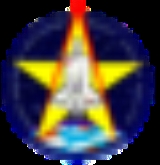
STS-53
Encyclopedia
Mission parameters
- MassMassMass can be defined as a quantitive measure of the resistance an object has to change in its velocity.In physics, mass commonly refers to any of the following three properties of matter, which have been shown experimentally to be equivalent:...
:- Orbiter landing with payload: 87565 kilograms (193,047.8 lb)
- Payload: 11860 kilograms (26,146.8 lb)
- PerigeePerigeePerigee is the point at which an object makes its closest approach to the Earth.. Often the term is used in a broader sense to define the point in an orbit where the orbiting body is closest to the body it orbits. The opposite is the apogee, the farthest or highest point.The Greek prefix "peri"...
: 365 kilometres (226.8 mi) - Apogee: 376 kilometres (233.6 mi)
- InclinationInclinationInclination in general is the angle between a reference plane and another plane or axis of direction.-Orbits:The inclination is one of the six orbital parameters describing the shape and orientation of a celestial orbit...
: 57.0° - PeriodOrbital periodThe orbital period is the time taken for a given object to make one complete orbit about another object.When mentioned without further qualification in astronomy this refers to the sidereal period of an astronomical object, which is calculated with respect to the stars.There are several kinds of...
: 92.0 min
Mission highlights
Discovery carried a classified primary payload for the United States Department of DefenseUnited States Department of Defense
The United States Department of Defense is the U.S...
, two unclassified secondary payloads and nine unclassified middeck experiments.
Discovery's primary payload, USA-89 NSSDC ID
International Designator
The International Designator, also known as COSPAR designation, and in the United States as NSSDC ID, is an international naming convention for satellites...
1992-086B is also known as "DoD-1", and was the shuttle's last major payload for the Department of Defense. The satellite was the second launch of a Satellite Data System
Satellite Data System
The Satellite Data System is a system of United States military communications satellites. At least three generations have been used: SDS-1 from 1976 to 1987; SDS-2 from 1989 to 1996; SDS-3 from 1998 to the present...
-2 military communications satellite, after USA-40 on STS-28
STS-28
STS-28 was the 30th NASA Space Shuttle mission, the fourth shuttle mission dedicated to United States Department of Defense purposes, and the eighth flight of Space Shuttle Columbia. The mission launched on 8 August 1989, lasted just over 5 days, and traveled 2.1 million miles during 81 orbits...
.
Secondary payloads contained in or attached to Get Away Special (GAS) hardware in the cargo bay included the Orbital Debris Radar Calibration Spheres (ODERACS) the combined Shuttle Glow Experiment/Cryogenic Heat Pipe Experiment (GCP).
Middeck experiments included Microcapsules in Space (MIS-l); Space Tissue Loss (STL); Visual Function Tester (VFT-2); Cosmic Radiation Effects and Activation Monitor (CREAM); Radiation Monitoring Equipment (RME-III); Fluid Acquisition and Resupply Experiment (FARE); Hand-held, Earth-oriented, Real-time, Cooperative, User-friendly, Location-targeting and Environmental System (HERCULES
Nikon NASA F4
The Nikon NASA F4 Electronic Still Camera was one of the first and rarest fully digital cameras ever. Constructed for NASA, it was first flown in September 1991 on board the Space Shuttle Discovery, mission STS-48...
); Battlefield Laser Acquisition Sensor Test (BLAST); and the Cloud Logic to Optimize Use of Defense Systems (CLOUDS).
Mission insignia
The five stars and three stripes of the insignia symbolize the flight's numerical designation in the Space Transportation System's mission sequence.See also
- Space scienceSpace scienceThe term space science may mean:* The study of issues specifically related to space travel and space exploration, including space medicine.* Science performed in outer space ....
- Space shuttleSpace ShuttleThe Space Shuttle was a manned orbital rocket and spacecraft system operated by NASA on 135 missions from 1981 to 2011. The system combined rocket launch, orbital spacecraft, and re-entry spaceplane with modular add-ons...
- List of space shuttle missions
- List of human spaceflights chronologically
- Nikon NASA F4Nikon NASA F4The Nikon NASA F4 Electronic Still Camera was one of the first and rarest fully digital cameras ever. Constructed for NASA, it was first flown in September 1991 on board the Space Shuttle Discovery, mission STS-48...

